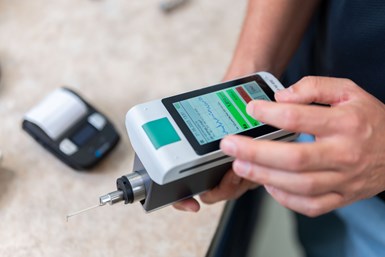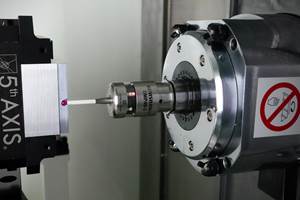More Surface Finish Parameters at Hand
Measuring surface finish at the point of manufacture is often done by the same machinist who is manufacturing the part. They need tools that meet test requirements and are easy to use.
With surface finish measurement, tighter dimensional tolerances often require additional information about the surface to ensure it functions per the design engineer’s requirements. Measuring surface finish at the point of manufacture is becoming more important — often by the same machinist who is manufacturing the part. While this machinist is typically an expert on running the machine, they are not necessarily an expert on making surface finish measurements (as well as related tasks like collecting and documenting data).
Thus, manufacturers need tools for operators that meet test requirements and are simple to use. For example, Roughness Average (Ra) is the go-to method for analyzing surface finish for many applications. Pocket-sized portable surface gages are ideal for these basic measurements. With their small size, robustness and simple, one-button operation, manufacturers have successfully used them for roughness measurements on the shop floor for more than 25 years.
However, while Ra may be the go-to method for a quick surface analysis, it may not be enough to qualify that the surface will meet its design requirements. How a surface is designed or manufactured often affects how it will perform. While there are more than 30 different roughness parameters, when deeply investigating how a surface might perform (no pun intended), it will require moving from a portable skidded system to a more capable, skid-less system. Skid-less systems allow for measuring roughness as well as waviness and profile of the surface.
With a skid-less roughness system, a reference surface is built into the drive that moves the stylus across it. Using this internal reference, we can measure profile, waviness and, of course, roughness. Thus, these tools offer the performance of high-end lab equipment but are packed into a portable system that can be used at the point of manufacture or built into custom fixtures.
Usability becomes a big issue: the latest portable surface gages interface with the user just like a smartphone. The unit's display adjusts to allow measurement in any position — horizontally, vertically or upside down — to provide the best viewing angle for the operator. They require very little training and can be used by the operator in minutes. Furthermore, the units are smart enough to automate filter setting and cut-off selection, providing the best results for the user. Users can also customize the screen and measurements to only see the results needed without sifting through a lot of unnecessary information. The display can be customized to show “favorite” functions, such as sending data or accessing specific trace details, for fast access to commonly used features.
Since the machinist has also become a surface finish inspector, they might as well have the tools to become a data collection, documentation and analysis expert too. New portable surface finish products make the collection or transfer of measurement results transparent to the user. With each measurement cycle, settings allow for results to be saved automatically on the device, both in data and PDF formats. At the same time, results can be sent automatically through an output connector (or wireless data transmitter) to a computer for Excel or third-party data collection and statistical process control (SPC) analysis. The profile information can also be transmitted wirelessly to a printer for an immediate hard copy to move along with the part. All of this is done with just the single start button and no added steps by the user.
Finally, with probes and styli being such precision, delicate and critical parts of the system, anything that can be done to make positioning easier for the operator will help prevent styli damage. One of the best operator savers is a breakaway magnetic styli holder. In the case of an accidental twitch or bump, the styli will break away without damage. If it does break away, simply reconnect to the auto-aligning magnetic coupler.
Additionally, many systems use autosensing of the part to speed positioning and help prevent damage. The user places the styli just above the part, not contacting, and starts the measuring cycle. The system takes over and moves the probe into position, to its mid-range, and then begins making the trace. This eliminates time-consuming alignments and probe damage and dramatically speeds up the measuring process. For repeat readings, there is ample room to remove and replace each sample part without re-aligning the surface gage.
Making high-precision surface waviness and profile measurements doesn’t always require that big system in the back corner of the manufacturing area; today, a portable system provides the same precision capabilities but is made to be used by the machinist at the point of manufacture.
Related Content
5 Things CNC Operators Must Know About Sizing Adjustments
For CNC operators, sizing adjustment is an essential skill. Keep these points in mind when training new CNC users.
Read More6 Machine Shop Essentials to Stay Competitive
If you want to streamline production and be competitive in the industry, you will need far more than a standard three-axis CNC mill or two-axis CNC lathe and a few measuring tools.
Read MoreUnderstanding Errors In Hand-Held Measuring Instruments
Different instruments (and different operators) are prone to different errors.
Read MoreWhat Should Machinists Know About In-Machine Probing?
In-machine probing doesn’t reach the power of CMMs but can still be useful for pre- and mid-process control, as well as for “rough screening” of parts.
Read MoreRead Next
3 Mistakes That Cause CNC Programs to Fail
Despite enhancements to manufacturing technology, there are still issues today that can cause programs to fail. These failures can cause lost time, scrapped parts, damaged machines and even injured operators.
Read MoreThe Cut Scene: The Finer Details of Large-Format Machining
Small details and features can have an outsized impact on large parts, such as Barbco’s collapsible utility drill head.
Read More













.png;maxWidth=300;quality=90)


.png;maxWidth=300;quality=90)










